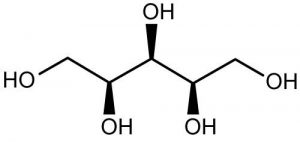Value Chain Management International published a report stating that food waste costs Canada $31 billion a year. The report found food waste accumulating in restaurants, retail stores, domestic homes, restaurants, hotels, food processing factories, farms, and many more. Unfortunately the report says the amount of food wasted can actually increase the cost of food by 10 percent or more! Peers, I don’t know about you, but as a full time student, passionate eater, and no-time employee, I am not interested in forking up any percent more money to feed my persistent stomach, or else my face will look just like this baby.

Image Credits: Elizabeth Delisi elizabethdelisi.blogspot.com
Luckily for us, Huaichen Zhang et al. at the Eindhoven University of Technology in the Netherlands, are developing a possible method to use sugar alcohols to store solar, and wind energy. The study uses naturally occurring xylitol and erythritol (molecular structures shown below). Both of which are often used as natural sweeteners. They investigated nanoscale heat transfer (NHT) across carbon structures dissolved in these compounds. The researchers used several sizes of carbon nanotubes (cylindrical forms of carbon depicted in the image below) submerged in the sugar alcohols, and employed various analytical techniques, and computer simulations, to observe the movements of the molecules and quantify the thermal conductance across them.

Structure of Xylitol. Image Credits: Century Stone Dental http://www.centurystonedental.com/blog/health-benefits-of-xylitol/

Structure of Erythritol. Image Credits: Wikipedia https://en.wikipedia.org/wiki/Erythritol

Carbon Nanotube. Image Credits: Gaia Technologies http://www.gaia3d.co.uk/3d-models/3d-chemistry/carbon-nanotube/Nanotube
Most people are familiar with macroscale heat transfer: conduction, radiation, and convection. NHT on the other hand, is at a much smaller scale; it deals with heat transfer across atoms and molecules, as opposed to larger macroscopic objects. To put it into perspective, nano typically means 1 x 10-9.
NHT can be applied to modern technology. This includes improving the efficiency of energy conversion and storage. Alan McGaughey, a professor at Carnegie University, studies NHT, and thermal conductivity. He shows the importance of understanding heat transfer at the atomic level in order to advance technology and science. For example, further research of NHT could improve the energy conversion of light to electricity in LEDs.
In conclusion of the Netherlands study, they found that smaller diameters of the nanotubes led to less heat transfer within the mixture. However, higher density combinations of the mixtures led to more heat transfer!
If Zhang, et al. can investigate the use of carbon and sugar alcohols in NHT to improve thermal storage, there may be hope for the food waste problem. The sugars and materials found in food waste could potentially be the key to better thermal energy storage, and therefore it wouldn’t really be considered waste after all!
This research contributes to a stronger understanding of the conductivity of carbon nanotubes, significance of nanoscale heat transfer, possible applications of these understandings, and most importantly brings forward a way to use all of the waste our species is contributing to the world!
Hooray for science!
– Nicole Yipp
References:
- Huaichen Zhang, Camilo C. M. Rindt, David M. J. Smeulders, Silvia V. Nedea. Nanoscale Heat Transfer in Carbon Nanotubes – Sugar Alcohol Composite as Heat Storage Materials. The Journal of Physical Chemistry C, 2016; DOI:10.1021/acs.jpcc.6b05466
- Luo, T.; Chen, G. Physical Chemistry Chemical Physics 2013, 15 (10), 3389.
- Chen, G.; Borca-Tasciuc, D.; Yang, R. G. Encyclopedia of Nanoscience and Nanotechnology 2004, 7, 429–459
- American Chemical Society (ACS). “Food waste could store solar, wind energy.” ScienceDaily. www.sciencedaily.com/releases/2016/09/160915133240.htm (accessed October 3, 2016)

